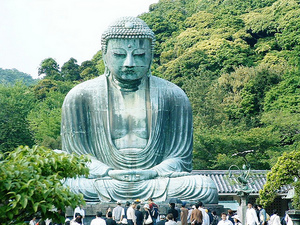Buddhism
- Japanese: 仏教 (bukkyou)
History
Introduction to China
Buddhism was first introduced into China around the first century CE, as missionaries from India crossed the steppes and entered China. Many Central Asian regions, and their rulers, converted in the second century, and by the third century, Chinese scholar-elites were familiar with Buddhism. The religion did not take hold in any widespread way in elite Chinese society until the fifth century, though, and began to gain popularity among the masses in the sixth century.
Mayahana Buddhism, which allowed for a syncretic pantheon of Buddhist deities, incorporating figures from Chinese folk religions alongside numerous other Buddhas and bodhisattvas, of whom the historical Buddha was only one, took root relatively easily in China, as compared to Theravada Buddhism, which focused more strongly on the historical Buddha and his teachings. Buddhist concepts such as karma also shifted and changed, adapting for example to the Chinese focus on the family, and on ancestors, rather than on individual honor or virtue.
The rulers of the Northern Wei Dynasty (386-534) were among the first, and most prominent, to convert to Buddhism and advocate its spread. Buddhism gained significant traction in southern China at that same time. Shrines and temples began to be built, and monks and their institutions to gain wealth and power as elites, inspired by the idea of gaining spiritual merit through acts of faith and charity, began to donate land and funds to Buddhist institutions.
Buddhism gained more widespread popularity (i.e. among the masses) in the sixth century, as it began to take on new forms specifically adapted to Chinese society, and became more accessible to the masses. The emergence of Pure Land Buddhism at this time was a key element of these developments, focusing on the idea of salvation through faith, committing oneself to a spiritual and upright life, and through the aid of compassionate deities, especially Amitabha (Amida Buddha, the Buddha of the Western Paradise, i.e. the Pure Land) and Guanyin (J: Kannon), the bodhisattva of compassion. Other forms of Buddhism required its devotees to possess significant wealth (to donate to Buddhist temples), leisure time (to devote to prayer, ritual, and study of religious texts), and learning (to study the religious texts, and to perform complex rituals); by contrast, Pure Land Buddhism focused on simpler rituals, and expressions of faith.
Chan Buddhism (J: Zen) was another major form of Buddhism to develop in China, gaining a widespread following among elites in the 8th century. Like Pure Land Buddhism, it rejected religious texts, deities, and complex (Esoteric) rituals, and focused instead on the personal pursuit of enlightenment, through meditation and spiritual contemplation of essential questions and concepts. Where Pure Land Buddhism placed relatively little focus on monasticism, however, being a more popular form of religion, Chan embraced the monastic tradition; the truest devotees of Chan Buddhism became monks, and devoted themselves to meditation and spiritual pursuits within a Chan monastery.
Introduction in Japan

The introduction of Buddhism to Japan from Korea is traditionally said to have taken place in 552.[1]
References
- Bonnie Smith et al. Crossroads and Cultures, vol. B, Bedford/St. Martins, 2012. pp312-314.
- ↑ Timon Screech, Obtaining Images, University of Hawaii Press (2012), 347.
